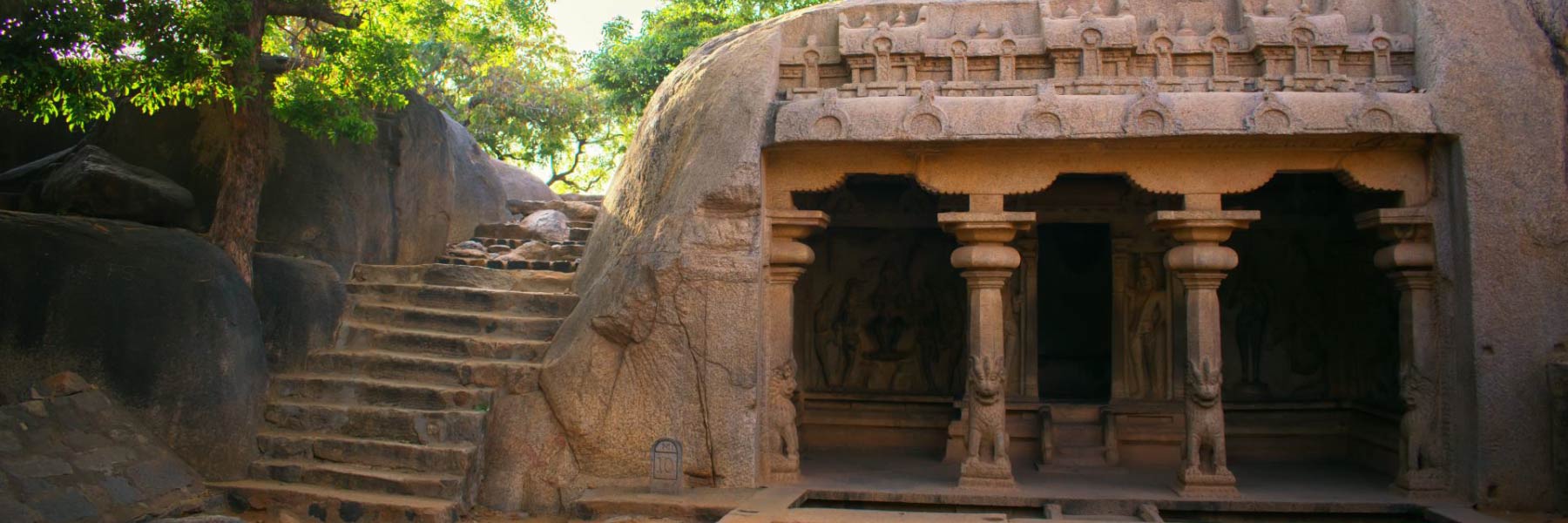
Sorry, we couldn't find anything that matches your search.
Destination

Famous Places to Explore in Hyderabad
A vibrant city with the imposing...

Raipur Tourist Places | Best Place to Visit
The stronghold of several erstwhile...

Ahmedabad
Declared as India's first UNESCO World...
#
Mahishasuramardini Cave Temple
Located at the southern end of Mamallapuram Hill, Mahishasuramardini Cave Temple is noted for its reliefs that have been intricately carved into walls. One of these depicts Lord Vishnu sleeping on top of the coils of the king of serpents, Adisesha, while another relief displays Goddess Durga, atop her lion, fighting with the demon Mahishasura. Apart from these two bas-reliefs, the shrine in the centre of the temple holds an idol of Lord Murugan, seated between Lord Shiva and Goddess Parvati. Carved out of rocks, the temple depicts scenes from ancient Hindu epics, Puranas. The cave temple belongs to the 7th century, constructed under the Pallava dynasty (275 CE to 897 CE). The cave is a testimony to the fine craftsmanship of the Vishwakarma sculptors of that time.

Varaha Cave Temple
The Varaha Cave Temple is known for four exquisite carvings of Lord Vishnu, Goddess Gajalakshmi, Lord Trivikama (the fifth avatar of Lord Vishnu) and Goddess Durga. This hilltop temple has exquisite rock-cut formations that are a fine example of the sculpting work done by Vishwakarmas of that century. The most prominent sculpture is of Lord Vishnu's incarnation as a Varaha (boar), who is lifting Bhudevi (Mother Earth) out of the ocean to rescue her. Several other mythical characters have been etched on the walls of this cave temple, along with ornate images of majestically seated lions. The outward-facing panels are graced by Goddesses Lakshmi and Durga. On the right-hand panel, upon entering the cave, one can see Lord Vishnu on an eight-armed giant form, called Trivikarma, in the act of killing the demon Mahabali. Dating back to the 7th century, this temple is also known as the Adhivaraha Cave Temple.

Trimurti Cave Temple
Trimurti is a triple-celled temple, dedicated to the holy trinity of Hinduism, the three superpowers Lord Brahma, Lord Vishnu and Lord Shiva. Situated at the northern end of the Mamallapuram Hill, slightly away from Krishna's Butter Ball, one can visit this cave temple to witness the splendour of Pallava dynasty's architecture. Apart from the trinity, the backside of the rock cave is adorned with fine carvings of elephants. These caves are among the very few in India that can be categorised as complete excavations. The three shrines of the cave temple have been excavated on the western facade of a hill and there are different staircases to reach all the three shrines. The three shrines are also decorated with a set of intricately carved dvarpalas or gatekeepers.

Shore Temple
Classified as a UNESCO World Heritage Site, Shore Temple is the oldest, free-standing temple in the vicinity of Mamallapuram. Belonging to the latter half of the 7th century, it is a perfect exhibit of Dravidian and Pallava architecture, built under the king Narasimhavarman II (695-722), with granite. Under the same king, the temple acted as an extremely busy port for a long duration. Within the temple, are three sanctums with shrines, two of which are dedicated to Lord Shiva and one dedicated to Lord Vishnu. Standing at the coast of the Bay of Bengal, the Shore Temple is only one of a complex of seven that survived the Tsunami in 2004. Even though many of the carvings in the temple have eroded over time, the quality of the exquisite carvings can still be made out. The Shore Temple, two-towered, stands magnificently in rock-cut elegance and is surrounded by gardens and ruined courts. There are several other smaller shrines in the vicinity complementing this huge building.







